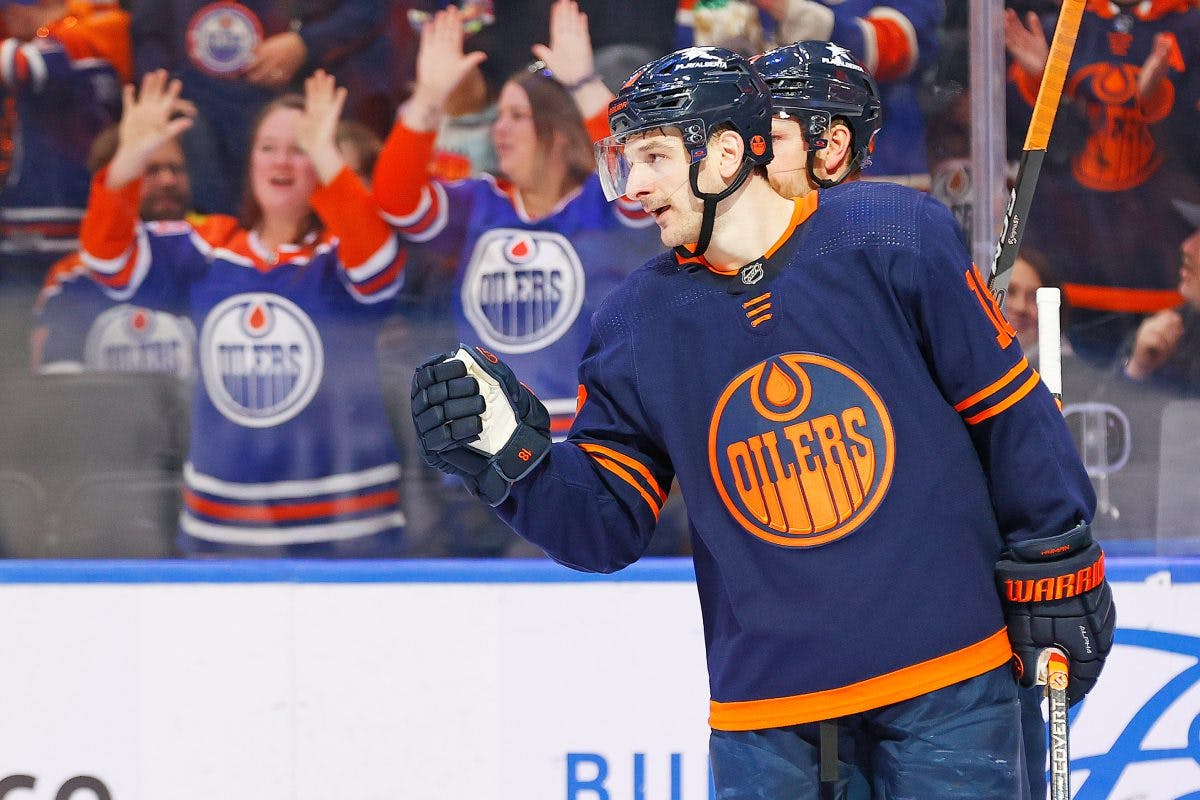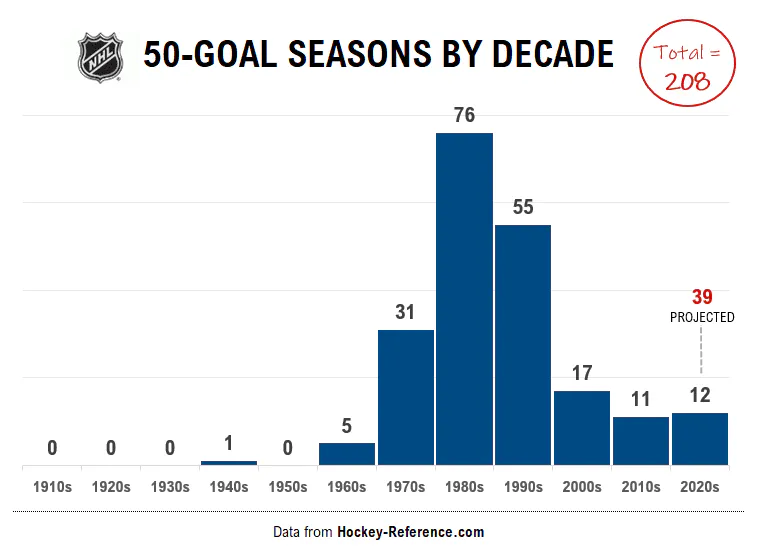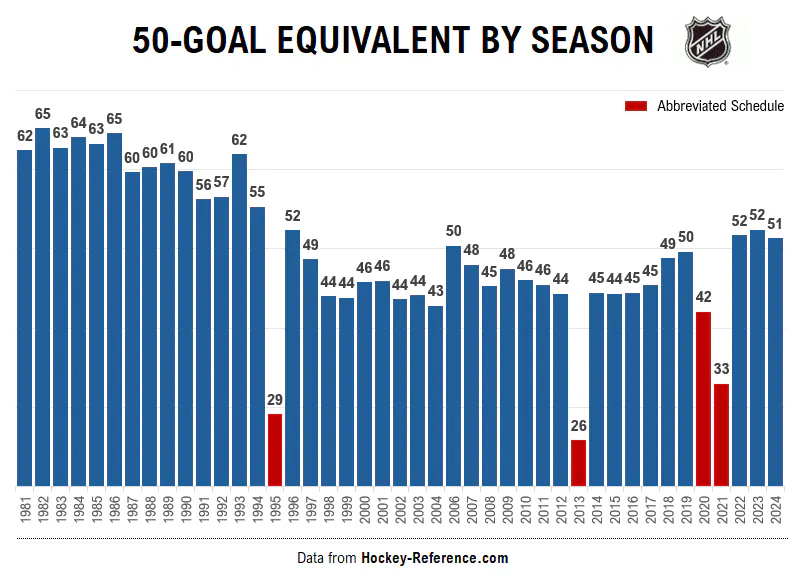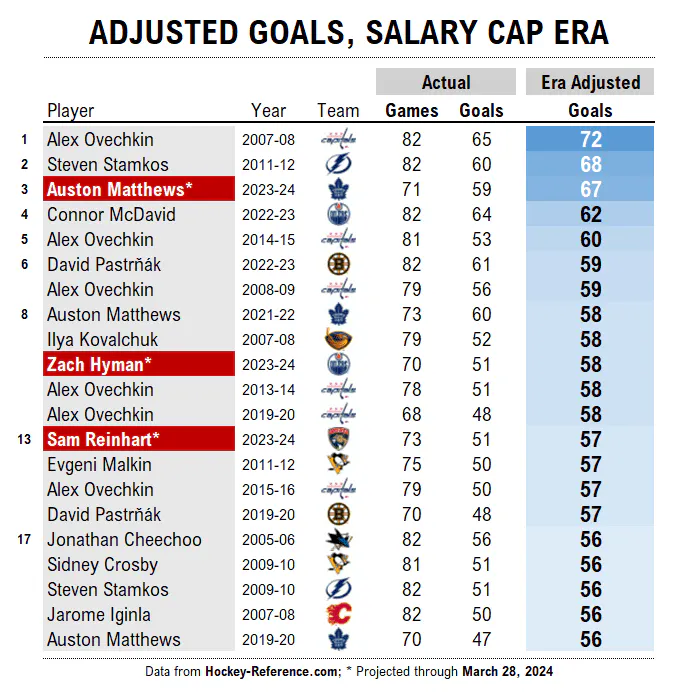50 Goals: Matthews, Hyman, Reinhart and what it means in today’s NHL

Every generation has their high-profile 50-goal scorer… Auston Matthews. Alex Ovechkin. Pavel Bure. Mario Lemieux. Wayne Gretzky. Guy Lafleur. Phil Esposito. Bobby Hull. Rocket Richard.
But who in October had Zach Hyman or Sam Reinhart joining the prestigious club? Hyman, the 31-year-old worker bee, had somehow managed 36 last season — easily a career high. Reinhart, the second overall pick in the 2014 NHL Entry Draft, had gradually rounded into a responsible 30-goal center.
But 50? That’s a milestone for the game’s most iconic snipers.
In Seinfeld terms, it’s like George being hired by the Yankees. Ruth, Gehrig, DiMaggio, Mantle… Costanza?!
With 50-goal seasons top of mind, we’re diving into the celebrated feat. Is the milestone’s importance watered down? Was it ever that special? And where do the seasons of Matthews, Hyman, and Reinhart rank in the NHL’s modern Red Light District?
🚨 The Trend
To understand an accomplishment, we need to understand its past.
The 50-goal club was founded by Richard in 50 games in 1945. But with the NHL’s wartime product diluted, new rules transforming the sport, and scoring up 48% from five years earlier, Richard’s hallowed mark is shaky. It’s like scoring about 51 goals today in 82 games. As the NHL’s quality was restored, the record would take 16 years and 20 more games added to the schedule to be duplicated.
By the 1970s, you could expect a pack of cigarettes in locker room stalls and about three 50-goal guys per season — an impressive feather in a scorer’s cap. But in the 1980s featuring Peak Gretzky, the floodgates opened. The once-special milestone was destroyed, reached 76 times in a decade. Scoring 50 meant you were about a top-10 goal scorer in a 21-team league.

But by the mid-1990s, the 50-goal scorer was on the endangered species list along with the giant panda. Not long after a ridiculous 14 players scored 50+ in 1992-93, the unthinkable happened. In 1998-99, Teemu Selanne led the NHL with only 47 goals.
Scoring had cratered, goalies became highly trained specialists, and lockouts and eventually a pandemic shortened or eliminated five seasons. In a 23-year span, 50 goals was reached just 28 times. Ovechkin alone was responsible for eight of these 28 seasons, meaning there were 20 non-Ovechkin 50-goal seasons in nearly a quarter century.
The NHL record book would never be the same. For two decades, 50 goals and 100 points were attainable marks for any player in the running for the best on their team. The milestone had now become something only possible for the best in the world.
Fast forward to 2023-24. The club has three members already, plus another two — Nathan MacKinnon (45) and David Pastrnak (45) — on pace to join Matthews (59), Hyman (51), and Reinhart (51). The projection of 39 for this decade in the chart above assumes all five score 50 this year and that the NHL averages five members each of the next five years. It’s far from certain, given league-wide scoring levels may have plateaued.
🚨 50 Goals Over the Years
So in an NHL with an evolving scoring climate, what has 50 goals meant?
While “no one asks how” a goal went in, they probably should ask when.

Incredibly, based on the volume of goals in the 1980s, a player needed to score at least 60 to hit the equivalent of 50 goals in a neutral scoring season (i.e., one that averages six total goals per game).
Two of those seasons stand out even further. In 1981-82 (the year Gretzky set the all-time record of 92 goals) and 1985-86 (when there were more 40-goal scorers than franchises), you needed 65 goals to equate to 50 in an average NHL season.
Ignoring the abbreviated schedule years, the fewest goals need to match the 50-goal equivalent was 2003-04 — the last season before the lockout. Jarome Iginla, Rick Nash, and Ilya Kovalchuk famously earned a share of the Rocket Richard Trophy with just 41 goals each.
In the post-COVID NHL, we’ve seen a modest rebound in offence, aided by some combination of power play efficiency, empty net goals, and a greater share of games decided in overtime. It’s a welcome sight to those who watched Jagr, Crosby, and Ovechkin peak in a below-average scoring era.
🚨 50 Goals Today
Shifting to the present day, where does that leave Matthews, Hyman and Reinhart?
We know the current NHL is more or less a normal scoring year in the grand scheme — neither particularly beneficial nor harmful to totals. Let’s check the era adjusted goals leaderboard since the introduction of the salary cap. We’ll place a 60-game minimum to eliminate heavily projected totals from the abbreviated seasons of 2012-13 (lockout) and 2021-22 (COVID).

Even among the best of the era, our three contemporary seasons are spectacular:
- Matthews (67) is on pace to challenge Stamkos for best goal-scoring performance in 12 years.
- Hyman (58) has an outside shot at 60 and his scoring to date is top 10 in the last two decades.
- Reinhart (57) is also in rarified air, his current pace remarkably topping Crosby’s best count.
When a player reaches 50 goals with nearly a month left in the season — or almost two months in Matthews’ case — it’s the real deal. If each can finish strong down the final stretch, their monster years will hold up among the best in a generation.
🚨 Closing Thoughts
There’s a misconception that 50 goals was always the milestone of hockey’s offensive gods. A look at the career goal totals of some of the club’s members tells a different story: Jacques Richard (160), Jonathan Cheechoo (170), Wayne Babych (192), Gary Leeman (199).
Scoring that many goals should never be dismissed. But when 25% or more of your career total is in six months, it’s more a special year than a distinguished career. Both Reinhart (249 goals at age 28) and Hyman (200 goals at age 31) have a lot of runway to add to their career totals. Matthews is in an entirely separate conversation, destined for a future showdown with the all-time greatest snipers.
Scoring 50 is a remarkable accomplishment today. It’s a top-five mark in a 32-team league, achieved in a moderate scoring climate in an NHL with a global footprint attracting an unprecedently deep array of talent. It’s a legitimate measure of being among hockey’s best handful of scorers.
While it might not be the uber-exclusive feat of the 2000s or 2010s, the milestone had become so rare it was barely relevant. After facing extinction, 50 goals is back. It’s gradually been reintroduced into the wild. And it’s a special feat worth celebrating today.
Follow @AdjustedHockey on X; Data from Hockey-Reference.com
Recently by Paul Pidutti
- Connor Bedard’s Rookie Season: Where it Ranks and What it Means
- McDavid, Matthews, Hughes: Projecting Career Totals for the NHL’s Biggest Stars
- After 700 NHL Games, Leon Draisaitl is Already a Hall of Famer
- Have Four Forwards Ever Dominated an NHL Season Like This Before?
- Who is the Best American in NHL History?
More from Paul Pidutti
- Father Time 2025: Are McDavid, Binnington and others on the decline?
- Surprise: great players rarely make great NHL coaches
- Overtime, loser points unleashing chaos in NHL’s Season of Parity
- Projecting the 2026 Hall of Fame Class: Bergeron, Price and endless possibilities
- Hall of Fame tiers: Which NHL stars are destined for immortality?